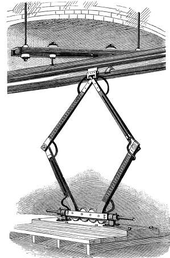Pantograph (transport)

A pantograph (or "pan" or "panto") is an apparatus mounted on the roof of an electric train, tram or electric bus[1] to collect power through contact with an overhead line. The term stems from the resemblance of some styles to the mechanical pantographs used for copying handwriting and drawings.
The pantograph is a common type of current collector; typically, a single or double wire is used, with the return current running through the rails. Other types of current collectors include the bow collector and the trolley pole.
Invention

The pantograph, with a low-friction, replaceable graphite contact strip or "shoe" to minimise lateral stress on the contact wire, first appeared in the late 19th century. Early versions include the bow collector, invented in 1889 by Walter Reichel, chief engineer at Siemens & Halske in Germany,[2][3] and a flat slide-pantograph first used in 1895 by the Baltimore and Ohio Railroad[4]
The familiar diamond-shaped roller pantograph was devised and patented by John Q. Brown of the
The pantograph was an improvement on the simple trolley pole, which prevailed up to that time, primarily because the pantograph allows an electric-rail vehicle to travel at much higher speeds without losing contact with the overhead lines, e.g. due to dewirement of the trolley pole.
Notwithstanding this, trolley pole current collection was used successfully at up to 140 km/h (90 mph) on the Electroliner vehicles of the Chicago North Shore and Milwaukee Railroad, also known as the North Shore Line.
Modern use
The most common type of pantograph today is the so-called half-pantograph (sometimes Z-shaped), which evolved to provide a more compact and responsive single-arm design at high speeds as trains got faster.
Technical details
The electric transmission system for modern
Pantographs are the successor technology to trolley poles, which were widely used on early streetcar systems. Trolley poles are still used by trolleybuses, whose freedom of movement and need for a two-wire circuit makes pantographs impractical, and some streetcar networks, such as the Toronto streetcar system, which have frequent turns sharp enough to require additional freedom of movement in their current collection to ensure unbroken contact. However, many of these networks, including Toronto's, are undergoing upgrades to accommodate pantograph operation.
Pantographs with overhead wires are now the dominant form of current collection for modern electric trains because, although more fragile than a third rail system, they allow the use of higher voltages.
Pantographs are typically operated by compressed air from the vehicle's braking system, either to raise the unit and hold it against the conductor or, when springs are used to effect the extension, to lower it. As a precaution against loss of pressure in the second case, the arm is held in the down position by a catch. For high-voltage systems, the same air supply is used to "blow out" the electric arc when roof-mounted circuit breakers are used.[12][13]
Single and double pantographs


Pantographs may have either a single or a double arm. Double-arm pantographs are usually heavier, requiring more power to raise and lower, but may also be more fault-tolerant.
On railways of the former

Metro systems and overhead lines

Most rapid transit systems are powered by a third rail, but some use pantographs, particularly ones that involve extensive above-ground running. Most hybrid metro-tram or 'pre-metro' lines whose routes include tracks on city streets or in other publicly accessible areas, such as (formerly) line 51 of the Amsterdam Metro, the MBTA Green Line, RTA Rapid Transit in Cleveland, Frankfurt am Main U-Bahn, and San Francisco's Muni Metro, use overhead wire, as a standard third rail would obstruct street traffic and present too great a risk of electrocution.
Among the various exceptions are several tram systems, such as the ones in
Overhead pantographs are sometimes used as alternatives to third rails because third rails can ice over in certain winter weather conditions. The
Numerous railway lines use both third rail and overhead power collection along different portions of their routes, generally for historical reasons. They include the
Until 2010, the
Three-phase supply

On some systems using three phase power supply, locomotives and power cars have two pantographs with the third-phase circuit provided by the running rails. In 1901 an experimental high-speed installation, another design from Walter Reichel at Siemens & Halske, used three vertically mounted overhead wires with the collectors mounted on horizontally extending pantographs.[16][17]
Inclined pantographs

On lines where open wagons are loaded from above, the overhead line may be offset to allow this; the pantographs are then mounted at an angle to the vertical.[18]
Weaknesses
Contact between a pantograph and an overhead line is usually assured through a block of graphite. This material conducts electricity while working as a lubricant. As graphite is brittle, pieces can break off during operation. Bad pantographs can seize the overhead wire and tear it down, so there is a two-way influence whereby bad wires can damage the pantograph and bad pantographs can damage the wires. To prevent this, a pantograph monitoring station can be used. At sustained high speeds, above 300 km/h (190 mph), friction can cause the contact strip to become red hot, which in turn can cause excessive arcing and eventual failure.[19]
In the UK, the pantographs (
Automatic dropping device
Automatic dropping device (ADD) is a safety device that automatically lowers the pantograph on electric trains to prevent accidents in case of obstructions or emergencies.[20][21] It is also known as pantograph dropping device.[22] The automatic dropping device is obligatory for trains with operational speeds of 160 km/h and higher. Otherwise, the train operators are free to install these devices. The damage that causes the pantograph to fall can include the strip head, the pantograph head and other parts. The ADD mostly uses a pneumatic system to detect a damage. For example, a broken contact strip will cause a pressure drop in the air tube inside.
See also
- Bow collector
- Current collector
- Pantographs and underbody collectors
- Railway electrification system
- Trolley pole
References
- ^ "Solaris Urbino". Busworld. 4 September 2016.
- ^ "A Century of Traction. Electrical Inspections, page 7, by Basil Silcove". Archived from the original on 2015-04-02.
- ^ Italian Patent 35389/285, 18 December 1893; US patent 547031, 1 October 1895
- ^ "A ninety-six ton electric locomotive". Scientific American. New York. 10 August 1895.
- ^ US Patent No. 764,224
- ^ The Street Railway Journal, Vol.24, No.3, July 16, 1904, p.116
- ^ The Key Route, Harre Demoro, v.1, pp.16-17, publ. Interurban Press (1985)
- ^ Sappers, Vernon (2007). Key System Streetcars. Signature Press. p. 369.
- ^ Walter Rice and Emiliano Echeverria (2007). The Key System: San Francisco and the Eastshore Empire. Arcadia Publishing. pp. 13, 16.
- ^ Louis Faiveley, Current Collecting Device, US 2935576, granted May 3, 1960.
- ^ "Railway applications - Current collection systems - Technical criteria for the interaction between pantograph and overhead contactline (to achieve free access)" (PDF). National Standards Authority of Ireland. Retrieved 27 March 2020.
- OCLC 467723.
- OCLC 2683266.
- ^ Garfield, Graham. "Yellow Line". Chicago "L".org. Retrieved January 8, 2011.
- ^ exsuhmsgate2 (5 March 2010). "Oslo Metro in transition III: Frognerseteren line". Archived from the original on 2021-11-17 – via YouTube.
{{cite web}}: CS1 maint: numeric names: authors list (link) - ISBN 9783835631328.
- ^ "Walter Reichel". siemens.com. Retrieved 27 March 2020.
- ISSN 1234-5962.
- ISBN 0275973778.
- ^ Xin, Tingyu (1 July 2019). Non-invasive dynamic condition assessment techniques for railway pantographs. University of Birmingham.
- ^ "IEC 60494-1:2013 - IEC-Normen - VDE VERLAG". www.vde-verlag.de. Retrieved 3 August 2023.
- ^ "IEC 60050 - International Electrotechnical Vocabulary - Details for IEV number 811-32-22: "pantograph dropping device"". www.electropedia.org. Retrieved 9 August 2023.
